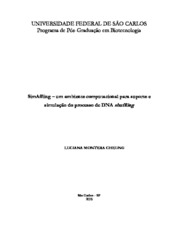| dc.contributor.author | Cheung, Luciana Montera | |
| dc.date.accessioned | 2016-06-02T19:02:39Z | |
| dc.date.available | 2009-09-10 | |
| dc.date.available | 2016-06-02T19:02:39Z | |
| dc.date.issued | 2008-11-06 | |
| dc.identifier.citation | CHEUNG, Luciana Montera. SimAffling um ambiente computacional para suporte e simulação do processo de DNA shuffling. 2008. 253 f. Tese (Doutorado em Multidisciplinar) - Universidade Federal de São Carlos, São Carlos, 2008. | por |
| dc.identifier.uri | https://repositorio.ufscar.br/handle/ufscar/249 | |
| dc.description.abstract | The Molecular Evolution of the living organisms is a slow process that occurs over the years producing mutations and recombinations at the genetic material, i.e. at the DNA. The mutations can occur as nucleotide remotion, insertion and/or substitution at the DNA chain. The Directed Molecular Evolution is an in vitro process that tries to improve biological functions of specific molecules producing mutations at the molecule s genetic material, mimicking the natural process
of evolution. Many technics that simulate in vitro molecular evolution, among them the DNA shuffling, have been used aiming to improve specific properties of a variety of commercially important products as pharmaceutical proteins, vaccines and enzymes used in industries. The original DNA shuffling methodology can be sumarized by the following steps: 1) selection of the parental sequences; 2) random fragmentation of the parental sequences by an enzyme; 3)
repeated cycles of PCR (Polymerase Chain Reaction), in order to reassemble the DNA fragments produced in the previous step; 4) PCR amplification of the reassembled sequences obtained in step 3). The DNA shuffling technic success can be measured by the number of recombinat molecules found at the DNA shuffling library obtained, since these recombinant molecules potentially have improved functionalities in relation to their parent since their sequence may accumulate beneficial mutations originated from distinct parent sequences. Nowadays some few models can be found in the literature whose purpose is to suggest optimization to this process aiming the increase of the genetic diversity of the DNA shuffling library obtained. This research work presents a comparative study of four models used to predict/estimate the DNA shuffling results. In addition a computational tool for simulating the DNA shuffling proccess is proposed and implemented in an environment where other functionalities related to the analyses of the parental sequences and the resulting sequences from the DNA shuffling library is also
implemented. | eng |
| dc.description.sponsorship | Financiadora de Estudos e Projetos | |
| dc.format | application/pdf | por |
| dc.language | por | por |
| dc.publisher | Universidade Federal de São Carlos | por |
| dc.rights | Acesso Aberto | por |
| dc.subject | Biotecnologia | por |
| dc.subject | Simulação (Computadores) | por |
| dc.subject | Evolução in vitro | por |
| dc.subject | DNA shuffling | por |
| dc.subject | Modelos de predição | por |
| dc.subject | Bioinformática | por |
| dc.subject | Biologia computacional | por |
| dc.subject | Computational simulation | eng |
| dc.subject | In vitro evolution | eng |
| dc.subject | DNA shuffling | eng |
| dc.subject | Predicting models | eng |
| dc.subject | Computational biology | eng |
| dc.subject | Bioinformatics | eng |
| dc.title | SimAffling um ambiente computacional para suporte e simulação do processo de DNA shuffling | por |
| dc.type | Tese | por |
| dc.contributor.advisor1 | Nicoletti, Maria do Carmo | |
| dc.contributor.advisor1Lattes | http://genos.cnpq.br:12010/dwlattes/owa/prc_imp_cv_int?f_cod=K4787728A5 | por |
| dc.description.resumo | A Evolução Molecular dos organismos vivos é um processo lento que ocorre ao longo dos anos e diz respeito às mutações e recombinações sofridas por um determinado organismo em seu material genético, ou seja, em seu DNA. As mutações ocorrem na forma de remoções, inserções e/ou substituições de nucleotídeos ao logo da cadeia de DNA. A Evolução Molecular Direta é um processo laboratorial, ou seja, in vitro, que visa melhorar funções biológicas específicas de
moléculas por meio de mutações/recombinações em seu material genético, imitando o processo natural de evolução. Diversas técnicas que simulam a evolução molecular em laboratório, entre elas a técnica de DNA shuffling, têm sido amplamente utilizadas na tentativa de melhorar determinadas propriedades de uma variedade de produtos comercialmente importantes como vacinas, enzimas industriais e substâncias de interesse famacológico. A metodologia original de DNA shuffling pode ser sumarizada pelas seguintes etapas: 1) seleção dos genes de interesse, dito parentais; 2) fragmentação enzimática dos genes; 3) ciclos de PCR (Polymerase Chain Reaction), para que ocorra a remontagem dos fragmentos; 4) amplificação das seqüências remontadas cujo tamanho é igual a dos parentais. O sucesso ou não da técnica de DNA shuffling pode ser medido pelo número de moléculas recombinantes encontradas na biblioteca de DNA shuffling obtida, uma vez que estas podem apresentar melhorias funcionais em relação aos parentais pelo fato de,
possivelmente, acumularem em sua seqüência mutações benéficas presentes em parentais distintos. Atualmente podem ser encontradas na literatura algumas poucas modelagens computacionais capazes de sugerir otimizações para o processo, com vistas em aumentar a diversidade genética da biblioteca resultante. O presente trabalho apresenta um estudo comparativo de quatros modelos para predição/estimativa de resultados de experimentos de DNA shuffling encontrados na literatura bem como a proposta e implementação de uma ferramenta computacional de simulação para o processo de DNA shuffling. A ferramenta de
simulação foi implementada em um ambiente que disponibiliza outras funcionalidades referentes à análise das seqüências a serem submetidas ao shuffling bem como ferramentas para análise das seqüências resultantes do processo. | por |
| dc.publisher.country | BR | por |
| dc.publisher.initials | UFSCar | por |
| dc.publisher.program | Programa de Pós-Graduação em Biotecnologia - PPGBiotec | por |
| dc.subject.cnpq | NAO CATEGORIZADO | por |
| dc.contributor.authorlattes | http://lattes.cnpq.br/1092296906422727 | por |
